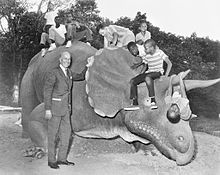Sidney Dillon Ripley
Sidney Dillon Ripley | |
|---|---|
Robert McCormick Adams | |
| Personal details | |
| Born | Sidney Dillon Ripley II September 20, 1913 New York City, New York |
| Died | March 12, 2001 (aged 87) Washington, D.C. |
| Nationality | American |
| Education | Yale University (BA) Harvard University (PhD) |
| Known for | Ornithology |
| Awards | Presidential Medal of Freedom (1985)[1] Padma Bhushan (1986)[2] |
Sidney Dillon Ripley II (September 20, 1913 – March 12, 2001) was an American ornithologist and wildlife conservationist. He served as secretary of the Smithsonian Institution for 20 years, from 1964 to 1984, leading the institution through its period of greatest growth and expansion. For his leadership at the Smithsonian, he was awarded the Presidential Medal of Freedom by Ronald Reagan in 1985.[3]
Biography
Early life
Ripley was born in New York City, after a brother, Louis, was born in 1906 in Litchfield, Connecticut.[4] His mother was Constance Baillie Rose of Scottish descent while his father was Louis Arthur Dillon Ripley, a wealthy real estate agent who drove around in an 1898 Renault Voiturette. Both his paternal grandparents, Julia and Josiah Dwight Ripley, died before he was born but he was connected to them through Cora Dillon Wyckoff. Great Aunt Cora and her husband, Dr. Peter Wyckoff, often hosted young Ripley at their Park Avenue apartment. Cora's and Julia's father (his great-grandfather) and partial namesake was Sidney Dillon, twice President of the Union Pacific Railroad.[5] and his uncle was Sidney Dillon Ripley I. Both Gilded Age tycoons.
Ripley's early education was at the Montessori Kindergarten School on Madison Avenue. As a young boy, he traveled widely including to British Columbia where his mother's relatives lived. In April 1918, his mother, who had separated from his father, moved to Cambridge, Massachusetts. In 1919 the family moved again to Boston, where he studied in a school called Rivers. At the age of ten, he traveled again with his mother across Europe. In 1924 Ripley went to a boarding school called Fay in Southborough, Massachusetts.
In 1926 he followed in Louis' footsteps, attending
Travel and education


A friend of the Ripleys,
War service and academic work
During
He joined the
Smithsonian Institution
He served as secretary of the
In 1967, he helped found the Smithsonian Folklife Festival, and in 1970, he helped found Smithsonian magazine. He believed that 75% to 80% of then-living animal species would become extinct in the next 25 years.[20]
In 1985 he was awarded the
Ripley successfully defended the National Museum of Natural History against a lawsuit that objected to the Dynamics of Evolution exhibit.[9]
Legacy

Ripley had intended to produce a definitive guide to the birds of
The Smithsonian's underground complex on the National Mall, the S. Dillon Ripley Center, is named in his honor. A garden between the Hirshhorn Museum and Sculpture Garden and the Arts and Industries Building was dedicated in 1988 to his wife, Mary Livingston Ripley.
The first-ever full-length biography of Ripley, The Lives of Dillon Ripley: Natural Scientist, Wartime Spy, and Pioneering Leader of the Smithsonian Institution by Roger D. Stone, was published in 2017.[24]
The
Selected writings
- The Land and Wildlife of Tropical Asia (1964; Series: LIFE Nature Library)
- Rails of the World: A Monograph of the Family Rallidae (1977)
- The paradox of the human condition : a scientific and philosophic exposition of the environmental and ecological problems that face humanity (1975)
- Birds of Bhutan, with Salim Ali and Biswamoy Biswas
- Handbook of the Birds of India and Pakistan, with Salim Ali (10 volumes)
- The Sacred Grove: Essays on Museums (London: Victor Gollancz Ltd, 1969)
Notes
- ^ "Announcement of the Recipients of the Presidential Medal of Freedom, April 8, 1985". The American Presidency Project. University of California, Santa Barbara. Retrieved 13 December 2013.
- ^ "Padma Awards" (PDF). Ministry of Home Affairs, Government of India. 2015. Retrieved July 21, 2015.
- ^ a b c d Molotsky, Irvin (13 March 2001). "S. Dillon Ripley Dies at 87; Led the Smithsonian Institution During Its Greatest Growth". The New York Times. p. 9.
- ^ "Louis R. Ripley". The New York Times. Mar 10, 1983. Retrieved Aug 12, 2020.
- ^ Stone (2017):1-5.
- ^ Hellman, Geoffrey T. "Curator Getting Around". The New Yorker. Retrieved Aug 12, 2020.
- ^ Stone (2017):10-15.
- ^ Stone (2017):25.
- ^ a b c "S. Dillon Ripley, 1913-2001". Smithsonian Institution Archives. Apr 14, 2011. Retrieved Aug 12, 2020.
- ^ Stone (2017):46.
- ^ Stone (2017):48-49.
- ^ a b c Lewis, Michael (2002). "Scientists or Spies? Ecology in a Climate of Cold War Suspicion". Economic and Political Weekly. 37.
- ^ Stone (2017):56-58.
- ^ Stone (2017):60.
- ^ Stone (2017):58.
- ^ Hellman, Geoffrey T. (1950) Curator Getting Around. The New Yorker. August 26, 1950.
- ^ Lewis, Michael (2003) Inventing Global Ecology: Tracking the Biodiversity Ideal in India, 1945-1997. Orient Blackswan. p. 117.
- ^ Stone (2017):75-76.
- ^ Stone (2017):66-68.
- ^ R Bailey (2000) Earth day then and now, Reason 32(1), 18-28
- ^ "S. Dillon Ripley". www.nasonline.org. Retrieved 2022-06-15.
- ^ "APS Member History". search.amphilsoc.org. Retrieved 2022-06-15.
- ^ "Sidney Dillon Ripley". American Academy of Arts & Sciences. Retrieved 2022-06-15.
- ISBN 978-1-5126-0061-2.
- ^ "LRWC - history". Archived from the original on 2010-05-09.
References
- Stone, Roger D. (2017) The Lives of Dillon Ripley. ForeEdge.
- Hussain, S.A. (2002). "Sidney Dillon Ripley II 1913–2001". Ibis. 144 (3): 550. .
External links
- Biography from the Smithsonian Institution Archives
- Biography and obituary in Smithsonian magazine
- Obituary in The New York Times
- Livingston Ripley Waterfowl Conservancy
